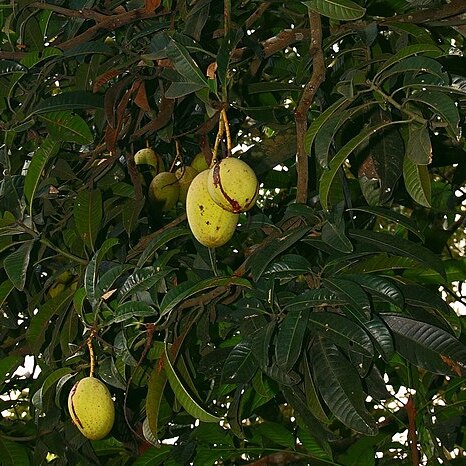Tree 10-40 m high and 30-100 cm Ø. Bark greenish or reddish brown, rough, fissured or scaly. Leaves rigidly coriaceous, oblanceolate, elliptic, elliptic-oblong, 14-35 by 6-16 cm (in vegetative or sapling state up to 37-48 by 15-18½ cm); base cuneate or attenuate; apex obtuse, rounded, sometimes slightly emarginate, rarely acute; nerves 15-33 pairs, prominent beneath, slightly elevated above; veins invisible or obscure on both surfaces; petiole 2-5(-8) cm (in vegetative or sapling state up to 12 cm), convex beneath, concave or flat above. Panicles terminal and sometimes also in the uppermost leaf axil, pyramidal, 10-40 cm long. glabrous; lateral branches up to 20 cm long, rather densely flowered; floral bracts ovate-lanceolate, 4-5 mm long; pedicels c. 1 mm. Flowers pinkish or deep red, fragrant. Calyx 5-lobed, lobes broadly ovate or ovate, 3-5 mm long, often glabrous, sometimes puberulous outside. Petals narrowly lanceolate, 6-9 by 1ll2-2ll2 mm; ridges 3, c. ½ the length of petals, confluent near the base. Disk pulvinate, stipe-like, c. 1 mm high. Stamens 5, 1 (rarely 2) fertile, 6-10 mm; filaments connate at the lower ¼-1 mm; anthers ellipsoid, c. ¾ mm long; staminodes 3-5 mm. Ovary subglobose, 1-1½ mm ø, (ochraceous when fresh, cf. OCHSE & BAKH. l.c.); style excentric, 5V2-7 mm. Drupe (fresh) (OCHSE & BAKH. l.c.) yellowish or greyish green, smelling and tasting of turpentine when ripe, obliquely ovoid, 8-10(-18) by 6-7(-12)cm; flesh yellow, fibrous, juicy, savoury, fragrant. Seed not labyrinthine.
More
A tree. It grows 10-27 m high. It has rough brown bark. The trunk is straight and can be 1 m across. It odes not have buttresses. The bark is brown and has broad flat cracks. The sap causes irritation and it turns black on exposure. The branches are large and the crown is dense. The leaves are dark green. They are oblong and 15-40 cm long by 9-15 cm wide. They are stiff and rough. They are dark green above and clear green underneath. The leaf stalks are 15.8 cm long and are stout with a fattened base. The flowering clusters are upright and form a pyramid shape. These can be 10-40 cm long. The flowers are pinkish red and do not have a scent. The flowers and dead leaves are found on the ground. Pink flowers are on red stems. The fruit is oval and 9-14 cm long by 5-10 cm wide. It is like a mango fruit. The fruit is dull green with a smooth skin. They have small dark spots. The flesh is fibrous and yellow. The juice has a strong smell of turpentine. The stone is plump and 6 cm long by 5 cm wide and 3 cm thick.
Widely cultivated in Malesia, sometimes as village trees. Escaped or naturalized, or indigenous in dryland lowland forests, rarely at 650-1000 m, very occasionally at c. 1400 m (Pahang, Kinabalu), once at 1800 m (Gajolands).
More
An upper canopy tree in primary lowland forest in the wet tropics, at elevations ascending to 1,500 metres. Usually growing on hillsides and ridges on sandy soils.
It is a tropical plant. They grow in the humid tropics. It grows from sea level to 1,000 or 1,500 m above sea level.
Uses. CORNER Ways. Trees 1940 109 says that the bachang can be told by stiff, dark-green leaves, like pieces of card-board, and by copper-red panicles with inodorous flowers, or by its stinking fruits, which are used in curries or pickles; the sweet variety is palatable raw and could be improved by selection. In flower, the bachang is the most beautiful Mangi-fera, with its upright panicles reminding of the horse-chestnut. Trees flower generally about March-April, and again in October in Singapore. It occurs common in orchards. See further HEYNE and BURKILL, ll.cc.; the latter noted some minor use of the sap for tattooing and medicinal.
More
The fruit are eaten once they are fully ripe. They are also used in chutney and pickles. The fruit has a turpentine smell which makes it less popular. CAUTION: The unripe fruit can irritate the skin. The ripe fruit is peeled thickly to avoid this. The unripe fruit are washed in salted water and sliced and used as a vegetable and in pickles.


